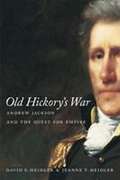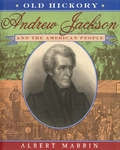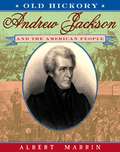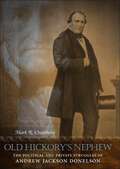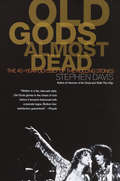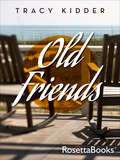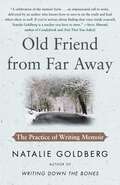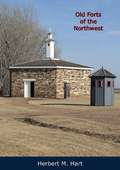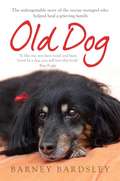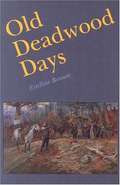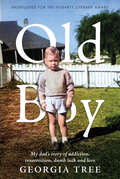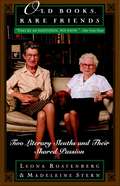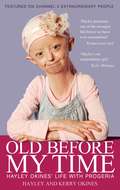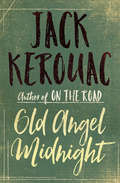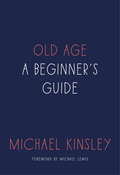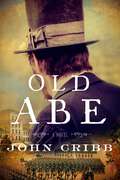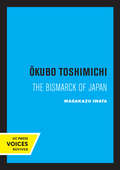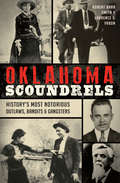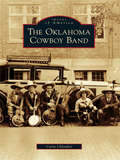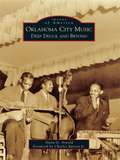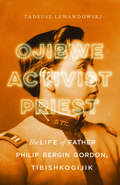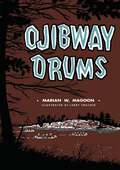- Table View
- List View
Old Hickorys War: Andrew Jackson and the Quest for Empire
by David S. Heidler Jeanne T. HeidlerTheir exciting narrative shows how the general's unpredictable behavior and determination to achieve his goals, combined with a timid administration headed by James Monroe, brought the United States to the brink of an international crisis in 1818 and sparked the longest congressional debate of the period.
Old Hickory:Andrew Jackson and the American People
by Albert MarrinFrom a childhood steeped in poverty, violence, and patriotic pride, Andrew Jackson rose to the heights of celebrity and power. The first popularly elected president, he won admiration by fighting corruption, championing the common man, shaping the power of the executive office, and preserving the fragile union of the young United States. Yet Jackson's ruthless pursuit of what he believed to be "progress" left indelible stains on the nation's conscience: broken treaties and the Trail of Tears are among Old Hickory's darker legacies. Vivid detail and unflinching analysis characterize Albert Marrin's fascinating rendering of the adventurous life, painful complexity, and continuing controversy that define the Age of Jackson.
Old Hickory: Andrew Jackson and the American People
by Albert MarrinFrom a childhood steeped in poverty, violence, and patriotic pride, Andrew Jackson rose to the heights of celebrity and power. The first popularly elected president, he won admiration by fighting corruption, championing the common man, shaping the power of the executive office, and preserving the fragile union of the young United States. Yet Jackson's ruthless pursuit of what he believed to be "progress" left indelible stains on the nation's conscience: broken treaties and the Trail of Tears are among Old Hickory's darker legacies. Vivid detail and unflinching analysis characterize Albert Marrin's fascinating rendering of the adventurous life, painful complexity, and continuing controversy that define the Age of Jackson.
Old Hickory's Nephew: The Political and Private Struggles of Andrew Jackson Donelson (Southern Biography Series)
by Mark R. CheathemThough remembered largely by history as Andrew Jackson's nephew, Andrew Jackson Donelson was himself a significant figure in nineteenth-century America: a politician, planter, diplomat, newspaper editor, and vice-presidential candidate. His relationship with his uncle and mentor defined his life, as he struggled to find the political and personal success that he wanted and his uncle thought he deserved. In Old Hickory's Nephew, the first definitive biography of this enigmatic man, Mark R. Cheathem explores both Donelson's political contributions and his complex, tumultuous, and often-overlooked relationship with Andrew Jackson. Born in Sumner County, Tennessee, in 1799, Donelson lost his father only five years later. Andrew Jackson soon became a force in his nephew's life, seeing in his namesake his political protégé. Jackson went so far as to predict that Donelson would one day become president. After attending West Point, Donelson helped establish the Jacksonian wing of the Democratic party and edited a national Democratic newspaper. As a diplomat, he helped bring about the annexation of Texas and, following in his uncle's footsteps, he became the owner of several plantations. On the surface, Donelson was a political and personal success.But few lives are so straightforward. The strong relationship between the uncle and nephew -- defined by the concept of honor that suffused the southern society in which they lived -- quickly frayed when Donelson and his wife defied his uncle during the infamous Peggy Eaton sex scandal of Jackson's first presidential administration. This resulted, Cheathem shows, in a tense relationship, full of distrust and suspicion, between Donelson and Jackson that lasted until the "Hero of New Orleans" died in 1845. Donelson later left the Democratic party in a tiff and joined the American, or Know Nothing, party, which selected him as Millard Fillmore's running mate in 1856. Though Donelson tried to establish himself as his uncle's political successor and legator, his friends and foes alike accused him of trading on his uncle's name to gain political and financial success.The life of Andrew Jackson Donelson illuminates the expectations placed upon young southern men of prominent families as well as the complexities and contradictions in their lives. In this biography, Cheathem awakens interest in a nearly forgotten but nonetheless intriguing figure in American history.
Old Gods Almost Dead: The 40-year Odyssey of the Rolling Stones
by Stephen DavisThe acclaimed, bestselling rock-and-roll biographer delivers the first complete, unexpurgated history of the world's greatest band. The saga of the Rolling Stones is the central epic in rock mythology. From their debut as the intermission band at London's Marquee Club in 1962 through their latest record-setting Bridges to Babylon world tour, the Rolling Stones have defined a musical genre and experienced godlike adulation, quarrels, addiction, legal traumas, and descents into madness and death_while steadfastly refusing to fade away. Now Stephen Davis, the New York Times bestselling author of Hammer of the Gods and Walk This Way, who has followed the Stones for three decades, presents their whole story, replete with vivid details of the Stones' musical successes and personal excesses. Born into the wartime England of air-raid sirens, bombing raids, and strict rationing, the Rolling Stones came of age in the 1950s, as American blues and pop arrived in Europe. Among London's most ardent blues fans in the early 1960s was a short blond teenage guitar player named Brian Jones, who hooked up with a lorry driver's only son, Charlie Watts, a jazz drummer. At the same time, popular and studious Michael Philip Jagger--who, as a boy, bawled out a phonetic version of "La Bamba" with an eye-popping intensity that scared his parents--began sharing blues records with a primary school classmate, Keith "Ricky" Richards, a shy underachiever, whose idol was Chuck Berry. In 1962 the four young men, joined by Bill Perks (later Wyman) on bass, formed a band rhythm and blues band, which Brian Jones named the "the Rollin' Stones" in honor of the Muddy Waters blues classic. Using the biography of the Rolling Stones as a narrative spine, Old God Almost Dead builds a new, multi-layered version of the Stones' story, locating the band beyond the musical world they dominated and showing how they influenced, and were influenced by, the other artistic movements of their era: the blues revival, Swinging London, the Beats, Bob Dylan's Stones-inspired shift from protest to pop, Pop Art and Andy Warhol's New York, the "Underground" politics of the 1960s, Moroccan energy and European orientalism, Jamaican reggae, the Glam and Punk subcultures, and the technologic advances of the video and digital revolution. At the same time, Old Gods Almost Dead documents the intense backstage lives of the Stones: the feuds, the drugs, the marriages, and the affairs that inspired and informed their songs; and the business of making records and putting on shows. The first new biography of the Rolling Stones since the early 1980s, Old Gods Almost Dead is the most comprehensive book to date, and one of the few to cover all the band's members. It is a celebration of the Rolling Stones as an often courageous, often foolish gang of artists who not only showed us new worlds, but new ways of living in them. It is a saga as raunchily, vibrantly entertaining as the Stones themselves.
Old Friends
by Tracy KidderA Pulitzer Prize–winning author&’s &“touching, funny and inspiring&” true story of daily life in a New England nursing home (The New York Times). Ninety-year-old Lou quit school after the eighth grade, worked for the rest of his life, and stayed with the same woman for nearly seventy years. Seventy-two-year-old Joe was chief probation officer in Pittsfield, Massachusetts, holds a law degree, and has faced the death of a son and the raising of a mentally challenged daughter. Now, the two men are roommates in a nursing home. Despite coming from very different backgrounds, the two become close friends. Focusing on these two men as well as introducing us to the other aging residents of Linda Manor in Northampton, Massachusetts, literary journalist Tracy Kidder examines the sorrows and joys of growing older and the universal struggle to find meaning in the face of mortality. From the New York Times–bestselling author and National Book Award–winning author of The Soul of a New Machine, this is an extraordinary look inside an often-hidden world. &“As in his Pulitzer Prize-winning The Soul of a New Machine, House, and the best-selling Among Schoolchildren, Kidder reveals his extraordinary talent as a storyteller by taking the potentially unpalatable subject of life in a nursing home and making it into a highly readable, engrossing account.&” —Library Journal &“Rich detail and true-to-the-ear dialogue let the brave and determined elderly speak for themselves—and for the continually surprising potential of the human spirit.&” —Kirkus Reviews
Old Friend from Far Away: The Practice of Writing Memoir
by Natalie Goldberg&“Memoir writers, buy this book, put it on your personal altar, or carry it with you as you traverse the deep ruts of your old road.&” —Tom Spanbauer, author of The Man Who Fell in Love with the Moon Old Friend from Far Away teaches writers how to tap into their unique memories to tell their story. Twenty years ago Natalie Goldberg&’s classic, Writing Down the Bones, broke new ground in its approach to writing as a practice. Now, Old Friend from Far Away—her first book since Writing Down the Bones to focus solely on writing—reaffirms Goldberg&’s status as a foremost teacher of writing, and completely transforms the practice of writing memoir. To write memoir, we must first know how to remember. Through timed, associative, and meditative exercises, Old Friend from Far Away guides you to the attentive state of thought in which you discover and open forgotten doors of memory. At once a beautifully written celebration of the memoir form, an innovative course full of practical teachings, and a deeply affecting meditation on consciousness, love, life, and death, Old Friend from Far Away welcomes aspiring writers of all levels and encourages them to find their unique voice to tell their stories. Like Writing Down the Bones, it will become an old friend to which readers return again and again.
Old Forts of the Northwest
by Herbert M. Hart Paul J. HartleBeyond the wide Missouri lay the prairie—“the biggest clearing on the Almighty’s footstool.” And every few hundred miles, holding to the rivers and wooded bottoms, were the outposts of the white civilization—the military forts of the U.S. Army. Father, mother and comforter to the settlers, trading points for the trappers and buffalo hunters, rallying points for the scouts.Awaiting the reader of this sentimental journey into the days of “Boots and Saddles,” are the graphic stories of battles against Indians and boredom. A military man, author Hart has the feel of these men who did the fighting and their places of conflict and refuge. He recounts the Bloody Bozeman outrage, Red Cloud’s War of 1866-68, and the pre-Civil War fights that seasoned lieutenants for the stars of Union and Confederate generals.It is a thrilling experience to read of the forts that opened the West for the stages, river boats and wagon trains...of those that protected the white man from the Indians and others that protected Indians from the whites...of those “hog and hominy” forts that gave solace to settlers who waited for the Indian attacks that never came...of the places called “Hog Ranches” that provided soldiers with entertainment lacking at Army posts...and of those forts George Armstrong Custer called home.With all this there are portraits, in both word and photograph, of the many famous generals who rode this frontier of history: Sherman, Sheridan, Crook, Custer, Harney, Sully, Connor, Mackenzie, Howard, Miles, Terry, Carrington, de Trobriand, Gibbon and Canby.
Old Dog
by Barney BardsleyMuffin was a rescue dog, an ordinary mongrel who joined the Bardsley family in Leeds in 1999. She was three years old, a 'little shipwreck' of a dog who had been badly neglected, undernourished and contained in a high-rise flat for whole of her young life. The family she came into was also under pressure, as the writer's husband Tim was in the middle of a long struggle with cancer and had been told earlier that year that his illness was terminal. Never having previously shown interest in animals, Tim bonded almost instantly with chaotic little Muffin, who became a steadfast companion during his final months. And during the dark days after Tim's death, and when the author's daughter left for university, Muffin became a loyal friend with an uncanny ability to display empathy around times of illness and loss. With Muffin reaching the end of her days, author Barney Bardsley looks back over the eventful years they have shared, to remember the joy and laughter that this loving, soulful creature brought to her family. Her story will strike a chord with anyone who has ever loved, and been loved, by a pet.
Old Deadwood Days
by Estelline Bennett(from the backover) For roughnecks in search of trouble, Deadwood was the place to go. An outlaw town-its very beginnings as a mining camp violated government treaties with the Sioux-Deadwood soon acquired a reputation that dime novels could hardly exaggerate. It attracted both the great and the gritty. Calamity Jane lived there, Wild Bill Hickok was shot in the back there, and Buffalo Bill was an irregular visitor, not to mention Seth Bullock, Mineral Jack, Slippery Sam, Cold Deck Johnny, and Belle Haskell, the best-known madam in town. To reform the town's notorious habits, Federal Judge Granville G. Bennett moved to Deadwood with his family in 1877, and his young daughter, Estelline, grew up with the town. She saw it change from a congeries of horse thieves, claim jumpers, road agents, painted ladies, and slick or shabby gamblers to a middle- class railroad town, a little dazed by its history and success. Her story of the settlement that grew up around Deadwood Gulch remains one of the finest and fullest accounts of the taming of the West.
Old Boy
by Georgia TreeHer whole life, Georgia' s father has told her she will be the one to write his story. It' s a story in which living is just a game of chance: why did Grant Tree survive when others didn' t? Why did he find love and happiness, and a grown daughter to spill his story to so that she can record the whole beautiful, unlikely mess of it? Told in parallel to Grant' s story is the life of his friend and dealer Brian Geoffrey Chambers, known in the book as Charlie, who was ultimately executed in Malaysia for drug smuggling.
Old Books, Rare Friends: Two Literary Sleuths and Their Shared Passion
by Leona Rostenberg Madeline B. SternLouisa May Alcott once wrote that she had taken her pen for a bridegroom. Leona Rostenberg and Madeleine Stern, friends and business partners for fifty years, have in many ways taken up their pens and passion for literature much in the same way. The "Holmes & Watson" of the rare book business, Rostenberg and Stern are renowned for unlocking the hidden secret of Louisa May Alcott's life when they discovered her pseudonym, A.M. Barnard, along with her anonymously published "blood and thunder" stories on subjects like transvestitism, hashish smoking, and feminism.Old Books, Rare Friends describes their mutual passion for books and literary sleuthing as they take us on their earliest European book buying jaunts. Using what they call Finger-spitzengefühl, the art of evaluating antiquarian books by handling, experience, and instinct, we are treated to some of their greatest discoveries amid the mildewed basements of London's booksellers after the Blitz. We experience the thrill of finding one of the earliest known books printed in America between 1617-1619 by the Pilgrim Press and learn about the influential role of publisher-printers from the fifteenth century.Like a precious gem, Old Books, Rare Friends is a book to treasure about the companionship of two rare friends and their shared passion for old books.
Old Before My Time
by Hayley Okines Kerry Okines Alison StokesThe extraordinary life of Britain s 100-year-old teenager. Hayley Okines is like no other 13-year-old schoolgirl. Born with the rare genetic condition progeria, she ages eight times faster than the average person. In medical terms her body is like that of a 100-year-old woman. Yet she faces her condition with immense courage and a refreshing lack of self-pity. In Old Before My Time, Hayley reflects on her unusual life. Share Hayley s excitement as she travels the world meeting her pop heroes Kylie, Girls Aloud and Justin Bieber and her sadness as she loses her best friend to the disease at the age of 11. Now as she passes the age of 13 the average life expectancy for a child with progeria Hayley and her mum Kerry talk frankly about her hopes for the future and her pioneering drug trials in America which could unlock the secrets of ageing for everyone. . .
Old Before My Time
by Hayley OkinesHayley's an extraordinary girl -- Kylie Minogue Hayley just lights up a room. She's so full of happiness -- Lorraine Kelly Hayley Okines is like no other 13-year-old schoolgirl.In Old Before My Time, Hayley and her mum Kerry reflect on her unusual life. Share Hayley's excitement as she travels the world meeting her pop heroes Kylie, Girls Aloud and Justin Bieber and her sadness as she loses her best friend to the disease at the age of 11. Now as she passes the age of 13 - the average life expectancy for a child with progeria - Hayley talks frankly about her hopes for the future and her pioneering drug trials in America which could unlock the secrets of ageing for everyone...
Old Angel Midnight: Scattered Poems, The Scripture Of The Golden Eternity, And Old Angel Midnight (City Lights/grey Fox Ser.)
by Jack KerouacA sensory narrative poem capturing the rhythms of the universe and secrets of the subconscious with stunning linguistic dexterity from the author of On the Road A spontaneous writing project in the form of an extended prose poem, this sonorous and spiritually playful book is one of Jack Kerouac&’s most boldly experimental works. Collected from five notebooks dating from 1956 to 1959—a time in which Kerouac was immersed in Buddhist theory—Old Angel Midnight is comprised of sixty-seven short sections unified by an unwavering dedication to sounds, the subconscious, and verbal ingenuity.Friday Afternoon in the Universe, in all directions in & out you got your men women dogs children horses pones tics perts parts pans pools palls pails parturiences and petty Thieveries that turn into heavenly Buddha. Thus begins Kerouac&’s Joycean language dance. From birdsong to dharmic verse, street jargon to French slang, the resonances of the universe come blaring in though the windows, unfurling their meaning as the mind lets go and listens.
Old Age: A Beginner's Guide
by Michael Kinsley<P>Vanity Fair columnist Michael Kinsley escorts his fellow Boomers through the door marked "Exit." <P>The notorious baby boomers--the largest age cohort in history--are approaching the end and starting to plan their final moves in the game of life. Now they are asking: What was that all about? Was it about acquiring things or changing the world? Was it about keeping all your marbles? Or is the only thing that counts after you're gone the reputation you leave behind? <P>In this series of essays, Michael Kinsley uses his own battle with Parkinson's disease to unearth answers to questions we are all at some time forced to confront. "Sometimes," he writes, "I feel like a scout from my generation, sent out ahead to experience in my fifties what even the healthiest Boomers are going to experience in their sixties, seventies, or eighties." <P>This surprisingly cheerful book is at once a fresh assessment of a generation and a frequently funny account of one man's journey toward the finish line. "The least misfortune can do to make up for itself is to be interesting," he writes. "Parkinson's disease has fulfilled that obligation." <P><b>A New York Times Bestseller</b>
Old Abe: A Novel
by John CribbOld Abe, the sweeping historical novel from New York Times bestselling author John Cribb, brings America&’s greatest president to life the way no other book has before.Old Abe is the story of the last five years of Abraham Lincoln&’s life, the most cataclysmic years in American history. We are at Lincoln&’s side on every page as he presses forward amid disaster and fights to save the country. Beginning in the spring of 1860, the story follows Lincoln through his election and the calamity of the Civil War. During the war, he walks bloody battlefields in the North and the South. He peers down the Potomac River with a spyglass amid terrifying reports of approaching Confederate gunboats. Death stalks him: one summer evening, a would-be assassin fires a shot at him, and the bullet passes through his hat. At the White House, he weeps over the body of Willie, his second son to die in childhood. As he tries desperately to hold the Union together, he searches for a general who will fight and finds him at last in Ulysses S. Grant. Amid national and personal tragedy, he struggles to find meaning in the Civil War and bring freedom to Southern slaves. Central to this biographical novel is a love story—the story of Abraham and Mary Todd Lincoln&’s sometimes stormy yet devoted marriage. Mary&’s strong will and ambition for her husband have helped drive him to the White House. But the presidency takes an awful toll on her, and she grows increasingly frightened and insecure. Lincoln watches helplessly as she becomes emotionally unstable, and he grasps for ways to support her. As Lincoln&’s journey unfolds, Old Abe chronicles the final five, tumultuous years of his life until his eventual assassination at the height of power. Full of epic scenes from American history, such as the Gettysburg Address and the signing of the Emancipation Proclamation, it probes the character and spirit of America. Old Abe portrays Lincoln not only as a flesh-and-blood man, but a hero who embodies his country&’s finest ideals, the hero who sets the United States on track to become a great nation.
Okubo Toshimichi: The Bismarck of Japan (Publications of the Center for Japanese and Korean Studies)
by Masakazu IwataThis title is part of UC Press's Voices Revived program, which commemorates University of California Press’s mission to seek out and cultivate the brightest minds and give them voice, reach, and impact. Drawing on a backlist dating to 1893, Voices Revived makes high-quality, peer-reviewed scholarship accessible once again using print-on-demand technology. This title was originally published in 1964.
Oklahoma Scoundrels: History’s Most Notorious Outlaws, Bandits & Gangsters (True Crime)
by Robert Barr Smith Laurence J. YadonEarly Oklahoma was a haven for violent outlaws and a death trap for deputy U.S. marshals. The infamous Doolin gang's OK Hotel gunfight left five dead. Killers like Bible-quoting choir leader Deacon Jim Miller wreaked havoc. Gunslinger femme fatale Belle Starr specialized in horse theft. Wannabe outlaws like Al Jennings traded train robbing for politics and Hollywood films. And Elmer McCurdy's determination and inept skill earned him a carnival slot and the nickname "the Bandit Who Wouldn't Give Up." Historians Robert Barr Smith and Laurence J. Yadon dispel myths surrounding some of the most significant lawbreakers in Sooner history.
Oklahoma Cowboy Band, The (Images of America)
by Carla ChlouberThe Oklahoma Cowboy Band was the first western string band in the nation to broadcast over the radio and appear on vaudeville, drawing large audiences throughout the Midwest and Northeast. The band began in Ripley as Billy McGinty's Cowboy Band and first played over radio station KFRU in Bristow in May 1925. Billy McGinty was a Rough Rider with Theodore Roosevelt and performed in Buffalo Bill's Wild West Show. The public responded to the broadcast of his band with a steady stream of telegrams, telephone calls, and letters asking for more of that old-time cowboy music. Soon Otto Gray and his wife, Mommie, of Stillwater joined the band, with both performing rope tricks, Mommie singing sad songs, and their son, Owen, performing comedy routines as "the Uke Buster." Renamed Otto Gray and His Oklahoma Cowboys, the band traveled for a decade to such cities as St. Louis, Chicago, Cincinnati, Indianapolis, Pittsburgh, and Syracuse. Its custom-built Cadillacs drew crowds wherever the band went. By the early 1930s, other acts were copying the band's cowboy themes and songs, and Otto Gray's lawyers threatened legal action. The lawyers met with only limited success, though, and today the cowboy image is firmly established in country music, thanks in large part to the early success of Billy McGinty, Otto Gray, and the Oklahoma Cowboy Band.
Oklahoma City Music: Deep Deuce and Beyond (Images of America)
by Charles Burton Jr. Anita G. ArnoldOklahoma City's rich music history traces back to Deep Deuce, the heart of the African American community that became an important resource for national jazz and blues bands seeking talented musicians who were often classically trained. Two icons and many legends are among the famous sons and daughters who lived in this cultural Mecca. Oklahoma City's Music: Deep Deuce and Beyond details the birth and growth of music in Oklahoma City's African American community from the 1920s until the late 1990s. Musical influences of families and individuals, venues, dance, and fashion blend with new-era traditions such as parades, jam sessions, and street parties to create a culture that became well known. This book explores how the seeds of music so deeply planted in the early days continue to produce great musicians and how the influences of those icons will vibrate throughout future international generations.
Okla Hannali
by R. A. LaffertyAn historical novel about the life and times of the Indians forcibly moved to "Indian Territory" (now Oklahoma) in the late 1820's, through the death of the main character around 1900. Much of the novel is historically accurate. The protagonists, however, are very much larger than life. The main character in particular, a Choctaw named Hannali Innominee, is the stuff of tall tales, and in many ways similar to Paul Bunyan or Odysseus, but with a Native American rather than white or Greek flavor.
Ojibwe, Activist, Priest: The Life of Father Philip Bergin Gordon, Tibishkogijik
by Tadeusz LewandowskiOjibway Drums
by Marian W. MagoonOjibway Drums by Marian W. Magoon is a captivating novel that brings to life the rich traditions, culture, and resilience of the Ojibway people. With poetic prose and heartfelt storytelling, Magoon weaves a tale of identity, connection, and the enduring power of heritage in the face of change.Set in the lush forests and shimmering lakes of the Great Lakes region, the story follows a young Ojibway protagonist as they navigate the challenges of growing up in a world where modern influences and traditional ways of life collide. At the heart of the narrative is the ceremonial drum, a symbol of unity, spiritual connection, and the heartbeat of the Ojibway community. Through its rhythm, the protagonist discovers a deeper understanding of their culture, family, and the values that define their people.Magoon’s storytelling is infused with vivid descriptions of Ojibway customs, legends, and ceremonies, offering readers an authentic glimpse into the community’s way of life. As the protagonist faces personal struggles and larger societal pressures, they embark on a journey of self-discovery and reconciliation, guided by the wisdom of elders and the powerful symbolism of the drum.Ojibway Drums is a celebration of cultural preservation and the strength found in embracing one’s roots. Magoon’s narrative highlights themes of resilience, respect for nature, and the importance of storytelling in passing down traditions from one generation to the next.Perfect for readers of all ages, Ojibway Drums is an evocative and moving tale that will resonate with anyone who values the intersection of heritage, identity, and the timeless stories that connect us all. It’s a tribute to the enduring spirit of the Ojibway people and a reminder of the power of community and tradition.
